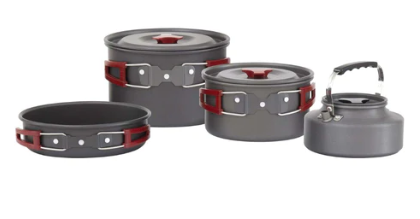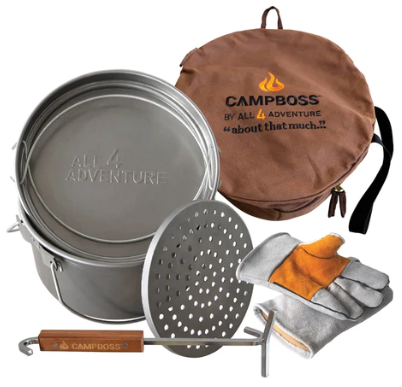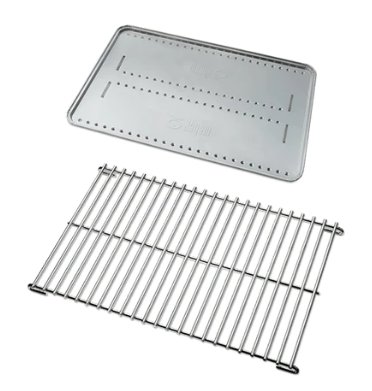A Guide To Camping Pans And Pots
Camping is a delightful escape from the hustle and bustle of daily life. As you embark on your outdoor adventure, one of the most important aspects to consider is your food setup. In this guide, we'll delve into the world of camping pans and pots – essential tools for preparing delicious meals while enjoying the great outdoors.
Types Of Camping Pans And Pots
-
Stainless steel camping pans and pots
Stainless steel offers durability and even cooking but can be heavier compared to other materials. It's a popular choice for camping.
-
Aluminium camping pans and pots
Aluminium pots and pans are lightweight and heat up quickly. However, they can react with acidic foods and might not be as durable as other options.

-
Cast iron camping pans and pots
Cast iron is excellent for cooking over a campfire due to its ability to withstand high temperatures. When cooking with cast iron over an open flame, ensure that the flames are not licking up the sides of the cookware, as this can lead to uneven heating and potentially damage the seasoning of the skillet.
-
Titanium camping pans and pots
Titanium pots and pans are lightweight, durable, and have excellent heat-conduction properties. They are popular among backpackers due to their low weight.
-
Non-stick camping pans and pots
Non-stick pans have a coating that prevents food from sticking, making them easy to clean. However, they might not be as durable as other options and can be damaged by high heat.
-
Enamel camping pots
Enamel camping pot is a type of cookware specifically designed for outdoor cooking during camping trips. These pots are made from metal with a coating of enamel, which is a type of glass fused to the metal surface through high heat. Enamel-coated camping pots offer even heat distribution, helping to prevent hot spots that could lead to uneven cooking.
-
Nesting camping cookware sets
Nesting camping cookware sets are a convenient and space-efficient solution for outdoor cooking. These sets consist of multiple pots, pans, lids, and sometimes utensils that are designed to fit together compactly, like Russian nesting dolls. They are ideal for backpackers, hikers, and campers who need to optimise space in their gear.

Essential Features To Consider In Selecting Camping Pans And Pots
When selecting camping pans and pots, there are several essential features to consider to ensure you choose the right cookware for your outdoor cooking needs. Here are the key features to keep in mind:
- Size and capacity: Choose cookware sizes that match your group size and the types of meals you'll be preparing. Consider both pots and pans for different cooking tasks.
- Weight: Consider the weight of the cookware, especially if you're backpacking or need to carry it over long distances. Lightweight materials like titanium and aluminium are great for this purpose.
- Heat Distribution: Even heat distribution ensures that your food cooks evenly. Materials like stainless steel and cast iron excel in this aspect.
- Non-Stick Coating: Non-stick surfaces are easy to clean and prevent food from sticking, but they may not be as durable as other options and can be damaged by high heat.
- Handles: Insulated, heat-resistant handles are essential for safe handling, especially when the cookware is hot. Foldable or removable handles can also save space during transport.
- Lids: Lids help retain heat and moisture, allowing for more efficient cooking. Some lids can also double as additional pans.
- Nesting capacity: If space is limited, consider collapsible or nesting cookware sets that can be stacked together to save space in your backpack or camping gear.
- Durability: Your camping cookware should be able to withstand the rigours of outdoor use. Look for sturdy construction and materials that can handle heat and physical stress.
- Compatibility: Ensure your cookware is compatible with the heat sources you'll be using, whether it's a campfire, portable stove, or other cooking apparatus.

- Easy to clean: Easy-to-clean surfaces can save you time and effort. Some cookware can be cleaned in a dishwasher, while others require hand washing.
Care And Maintenance Of Camping Pans And Pots
Proper care and maintenance of your camping pans and pots are crucial to ensure their longevity and optimal performance. Here's a guide on how to take care of your outdoor cookware:
- Cleaning: After cooking, let the cookware cool down a bit before cleaning. Use a soft sponge or cloth to wipe away any food residues. If the cookware has stuck-on food, you can soak it in warm water to loosen the debris.
- Seasoning cast iron: If you're using cast iron cookware, it's important to season it before and after each use. This involves applying a thin layer of oil to the surface and heating it to create a protective layer that prevents rust and enhances the non-stick properties.
- Drying: After washing, dry the cookware completely to prevent rust. You can dry it over a campfire, on a camp stove, or with a towel.
- Storing: Store your camping cookware in a dry and well-ventilated area. If possible, avoid stacking pots and pans directly on top of each other to prevent scratches and damage to non-stick coatings.
- Avoid extreme temperature changes: Rapid temperature changes can cause warping or cracking, especially in materials like cast iron. Avoid pouring cold water into a hot pot, for example.
- Use proper utensils: Opt for utensils that are safe for your cookware material. Avoid metal utensils on non-stick surfaces, as they can scratch the coating.
- Avoid metal-to-metal contact: Remember to avoid metal-to-metal contact when using and cleaning your camping pans and pots. Using metal utensils on metal surfaces can lead to scratches and damage. Opt for utensils made of wood, plastic, or silicone to preserve the integrity of your cookware.
- Remove stubborn stains: Always test a small, inconspicuous area first to ensure that the cleaning method won't damage the cookware's surface. Additionally, it's a good practice to avoid using abrasive materials on non-stick coatings, as they can scratch and damage the non-stick layer.
- Seasoning non-stick cookware: Non-stick cookware doesn't require seasoning in the same way that cast iron or certain other materials do. However, over time, the non-stick coating on your cookware might wear down, so avoid using metal utensils that can scratch the surface. Opt for wooden, silicone, or plastic utensils instead.
- Inspect regularly: Periodically inspect your cookware for any signs of damage, such as chipped coatings or deep scratches. Address these issues promptly to prevent further deterioration.
Safety Precautions When Using Camping Pans And Pots
Safety is paramount when using camping pans and pots to ensure a safe and enjoyable outdoor cooking experience. Here are some important safety precautions to keep in mind:
- Choose a stable cooking surface: When setting up your cooking area, make sure the surface is stable and level. This prevents accidental tipping of pots and pans.
- Keep flammable materials away: Place your cookware away from tents, shelters, and other flammable structures to prevent accidental fires.
- Use heat-resistant gloves or mitts: Always use oven mitts or heat-resistant gloves when handling hot cookware.
- Securely position handles: Keep handles and grips away from direct flames to avoid burns.
- Use heat-resistant utensils: These utensils are designed to withstand high temperatures without melting or warping, ensuring both your safety and the longevity of your cookware. Using heat-resistant utensils will prevent accidents, burns, and damage to your camping pans and pots.
- Monitor cooking progress: Never leave your cooking unattended. Always stay close to the cooking area to monitor the process. Regular monitoring ensures that your meals turn out just the way you want them – flavourful, safe, and perfectly cooked.
- Keep children and pets at a safe distance: Ensure that children and pets are at a safe distance from the cooking area to prevent accidents and burns.
- Use potholders or trivets: Potholders keep your hands safe from hot handles and trivets protect surfaces from heat-related damage.

- Be mindful of wind conditions: If cooking in windy conditions, position your stove or fire to minimise the risk of flames being blown onto your cookware or surroundings.
- Allow sufficient cooling time: Prior to handling, make sure your camping pots and pans have had time to cool down sufficiently. Burns or other injuries can be brought on by hot cookware. Till they reach a temperature where touching them is safe, let them sit undisturbed. This practice ensures your safety and prevents accidental burns.
Sustainable And Eco-Friendly Camping Pans And Pots
Using sustainable and eco-friendly camping pans and pots can contribute to reducing your environmental impact while enjoying outdoor cooking. Here are some tips and considerations for choosing and using eco-friendly cookware:
- Materials: Opt for camping pans and pots made from sustainable materials. Look for options like stainless steel, which is durable and can be recycled, or cookware with non-toxic ceramic coatings.
- Non-toxic coatings: Traditional non-stick coatings can release harmful chemicals when heated. Choose cookware with ceramic or other eco-friendly non-stick coatings that are free from PFOAs and PTFEs.
- Responsibly sourced: Some manufacturers use recycled materials to create cookware. Look for products that use recycled metal or plastic in their construction. Additionally, choose cookware that can be recycled at the end of its life.
- Energy efficiency: Use the right cookware size for your portions to minimise energy consumption. Avoid excessive heat that could damage the cookware or lead to inefficient cooking.
- Minimal packaging: Opt for cookware that comes with minimal packaging, preferably using recyclable or compostable materials.
- Multi-purpose functionality: Choose cookware that can serve multiple purposes, reducing the need to carry numerous items. For example, a versatile pot with a lid can also function as a pan.
- Biodegradable cleaning products: Use biodegradable, eco-friendly soap for cleaning your cookware. Ensure that you properly dispose of wastewater, keeping it away from water sources.
- Proper waste disposal: Follow Leave No Trace principles by packing out all your waste, including food scraps, and minimising the impact of your cooking activities on the natural environment.
- Longevity and durability: Invest in high-quality, durable cookware that will last for years. This reduces the need for frequent replacements and minimises waste.
- Consider second-hand options: Opting for second-hand cookware reduces the demand for new production, conserving resources and reducing waste.
To sum it up, this guide provides comprehensive insights into the world of camping pans and pots. From understanding various types and materials to considering essential features and safety precautions, you're now equipped with the knowledge to make informed choices for your outdoor cooking adventures.
Remember, whether you're prioritising sustainability, functionality, or both, the right camping cookware can enhance your camping experience while minimising your environmental impact. So go ahead, select your ideal cookware, take proper care of it, and enjoy delicious meals amidst the beauty of nature. Happy camping!

